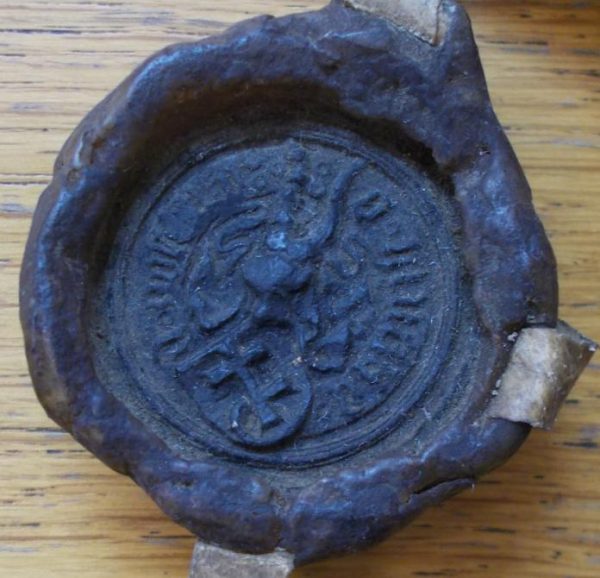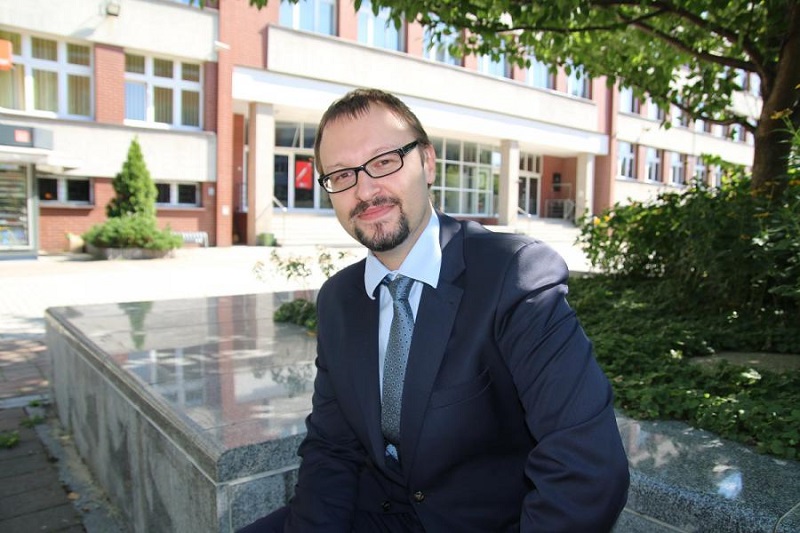| Maria Sztuka |
Many scientific publications have been written about the Opole knighthood. The stormy history of Opole Piasts, the territorial changes of the Duchy of Opole, and the significant political activities of the dukes of Opole have attracted the interest of medieval historians for a long time (e.g. publications by Marek Cerwiński and Ulrich Schmilewski). However, any and all deep syntheses end in the 13th century. In 2021, a large and beautifully produced monograph entitled Rycerstwo opolskie do połowy XV wieku [The Opole Knighthood until the mid 15th century] was published by the University of Silesia Press. Its author is Maciej Woźny, PhD, Assistant Professor at the Institute of History of the Faculty of Humanities of the University of Silesia.
His interest in the medieval warriors from Opole is the continuation of his student-time fascination with Prince Bolko V, who was the subject of the MA thesis of the future author of the monograph (Książę opolski Bolko V (ok. 1394/1400–1460). Biografia polityczna, 2008 r.) [Bolko V, Duke of Opole, approx. 1394/1400-1460. A political biography, 2008]
Political biography of Bolko V
‘While collecting the materials, I found many inaccuracies in the duke’s biography. In the 1950s, Bolko V grew up to the size of a monumental advocate of Polishness. His fight against German or Germanised Piasts was glorified, his support for the Hussite movement was exposed, and he was also associated with the rebirth of Slavic nations,’ recalls Maciej Woźny, PhD.
This figure inspired many historians. There was even a paper dedicated to the historiography on Bolko V that changed over the centuries: about his transition from a common duke to a superheretic, a religious outcast who sacrificed himself to fight the Church. As evidenced by the preserved documents, even plain transactions such as purchase of church properties was interpreted as the acts of struggle against clergy. However, the truth was much simpler. As explained by the Assistant Professor: the bishop needed money, and the prince had money, so one of them sold land, and the other one bought it.
‘My thesis is,’ adds the historian, ‘that following the first “visit” of Hussites, who burnt Bolko V’s duchy and its capital, the duke probably realised that it made more sense to communicate with them.’
When using different sources, the medievalist had to verify them in detail. The new perspective frequently consisted in deideologising certain historical studies. The mid-20th century literature was permeated with the interpretation of facts imposed back then, which brought many errors and inaccuracies to the image of the 15th century. The figure of Bolko V greatly matched the strongly exposed fight against the Church: not only was he favourable for Hussites, but also ignoring the currently effective religious law, he got married for the second time, although his first wife Elżbieta Granowska was still alive. He was believed to have been excommunicated by the Wrocław bishop, and got rich by taking over church property: quite an excellent model hero for the 1950s. However, a reliable document search did not confirm either the duke’s allegedly outstanding achievements or his great involvement in wars as a supporter of the Hussites. In his times, many dukes and aristocrats had conflicts with the Church, and a lot of them were excommunicated (including Bolko V’s father for his raid on church-owned villages); there was nothing extraordinary about it.
The documents do confirm Bolko V’s involvement on the Hussite side, but at the same time they illustrate different attitudes of dukes. His father, Bolko IV, did not support Hussites, but provided his son with gunpowder. On the contrary, Bolko’s father-in-law, Bernard of Niemodlin, fought the Hussites relentlessly. It is the fact that the route of Hussite conquers was far from the land of dukes of Opole. Bolko V did not gain much from the Hussite wars, although according to some literature sources he seized even up to half of the Upper Silesia. However, this account is untrue, because the duke lost almost all his battles at that time. On the other hand, saving the Opole Silesia from destruction was his unquestionable merit. While his neighbours reconstructed their burnt mansions and borrowed money to pay their military crew, Bolko V increased his assets.
Opole Knighthood
The people mentioned in the duke’s documents are a valuable source of information for historians. However, in the case of Opole princes, the material at the researchers’ disposal is very scarce and requires arduous, almost detective search. The vast resources gathered for the biography of Bolko V could not be put aside. This is where the idea for a doctoral paper came from. Its aim was to present Opole knighthood, which was anonymous for certain researchers: its geographical distribution, genealogy, as well as political activities from 1301 until the death of Prince Bolko V, i.e. the mid-15th century.
Documents from the medieval Duchy of Opole are significantly different from the ones that the historians dealing with the modern age have at their disposal. The medievalists cannot use diaries, letters, detailed parish entries, register books or court registers, because they did not appear in the Upper Silesia until the 16th century, unlike in the Lesser Poland, where they already existed back in the 15th century. This is an important difference in research on the local noblemen between the Kraków land and the Upper Silesia.

The identification of witnesses appearing in the documents contains a number of inaccuracies. The list of knights who participated in the duke’s expeditions gradually became more and more extensive. Therefore, the historian determined a precise framework. For him, ‘Opole knights’ are the ones who had property or held offices in the Duchy of Opole; he also added the witnesses whose signatures were on the documents drawn up by Opole princes, with the exception of those who came from locations outside the examined territories, and whose names appeared one time, deciding that they were related to the person for whom the prince issued the document, rather than representatives of the local community. After defending the PhD degree in 2017, encouraged by medievalists, he prepared a publication based on his doctoral paper. The chapter Genealogy and geographical distribution dedicated to the composition and locations of Opole knighthood was modified. The monograph contains 327 biograms (in alphabetical order): many of them were supplemented with genealogical trees if there were sufficient source materials, and the family bonds could be reconstructed.
‘One of the problems with identifying specific people is the repeatability of their names, which resulted from the common habit of giving the same name to children within a single family. The hints are included in dates and places. A historian must be particularly aware of who, where and when stayed or could have stayed, in all likelihood. In the case of many individuals these are real puzzles, which are difficult to solve due to gaps in sources. The stamps containing family coats of arms and owner’s name are helpful. Sometimes diminutives were used to distinguish between people bearing the same names: Mikosz, Jasiek, Dobko. Another distinguishing mark could be the place where a particular person had its residence: Henryk of Domanice, Henryk of Raków. Sometimes the adjective younger or older was added to the name: Stefan Strzała Starszy (Older), Stefan Strzała Młodszy (Younger). ‘The lists of witnesses are also very useful, because they included hierarchies according to the position or age of a specific person,’ explains the Assistant Professor.
The main place of study visits carried out by M. Woźny, PhD was the State Archive in Wrocław, which contains manuscript sources. The researcher also used the resources of State Archive in Opole and Katowice, where a collection of parchment documents is stored. Certain documents can also be found in foreign archives: in Prague, Brno, Opava, Olomouc and Berlin. Some of them are published in the form of regesta, while others are available in catalogues.
The use of regesta is not always possible. Many of them are limited to one-sentence summaries and ignore the witness lists, which are important for researchers; moreover, they contain numerous errors. Therefore, it is necessary to obtain the original documents, as long as they are available, because many of them were destroyed during World War II. M. Woźny, PhD thinks that despite the inaccuracies, the significance of regesta cannot be overstated, particularly those created before World War II, because they are sometimes the only trace of documents, although it is no longer possible to verify their accuracy.
Another valuable source of information is the declaration letters from the time of the Hunger War in 1414, i.e. Jagiełło’s struggle to regain all historical Polish lands, which had been taken over by the Teutonic Knights. Silesian dukes supported the Polish king. In line with the medieval ritual, when entering a conflict, the knights would declare the war against their enemy in writing. The war declaration letters have survived and are stored in the Berlin archive. The lists contain the names of over 200 knights, many of whom do not appear in any other documents. Traces of Opole knights can also be found in chronicles. For example, Jan Długosz, when describing the duke’s raid, mentioned the knights who had stood by his side. There are also preserved notes of townspeople’s complaints against the knights’ raids, including the list of incurred losses, as well as notes on activities during the Hussite wars, describing the achievements and names of the deceased knights.
Maciej Woźny, PhD is a history enthusiast, and the arduous search, determination in discovering truth and knowledge of the literature on the subject taught him to be patient and responsible for the written word. He checks his sources deeply and searches for new ones, while also finding inaccuracies and even errors in other papers. His future plans include working on the history of the Duchy of Bytom, in the chapter between the Dukes of Cieszyn and Oleśnica.
The article entitled „Anonymous knights” was published in the October issue of Gazeta Uniwersytecka UŚ (University of Silesia Magazine), no. 11 (291).
Maciej Woźny, PhD from the Institute of History of the University of Silesia in Katowice | photo by Agnieszka Sikora






